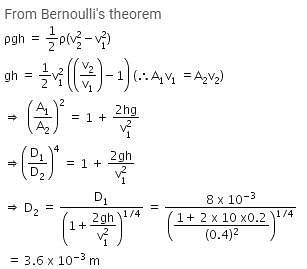Test: Pressure, Streamline flow & Bernoulli's Principle (21 August) - JEE MCQ
10 Questions MCQ Test Daily Test for JEE Preparation - Test: Pressure, Streamline flow & Bernoulli's Principle (21 August)
The pressure of 1 atm = ______ Pa
Which of the following is not an application of Pascal’s Law?
| 1 Crore+ students have signed up on EduRev. Have you? Download the App |
The pressure at the bottom of a tank containing a liquid does not depend on:
Find the density when a liquid 5 m high in a column exerts a pressure of 80 Pa.
Water is flowing continuously from a tap having an internal diameter 8 x 10-3 m. The water velocity as it leaves the tap is 0.4 ms-1. The diameter of the water stream at a distance 2 x 10-1 m below the tap is close to:
Bernoulli’s theorem includes as a special case of:
Air is streaming past a horizontal airplane wing such that its speed is 120 m/s over the upper surface and 90 m/s at the lower surface. If the density of the air is 1.3 kg/m3and the wing is 10 m long and has an average width of 2 m, then the difference of pressure on the two sides of the wing is
In the houses far away from the municipal water tanks often people find it difficult to get water on the top floor. This happens because
Water is flowing through a horizontal pipe in streamline flow at the narrowest part of the pipe:
Bernoulli’s principle is based on the conservation of:
|
360 tests
|


















